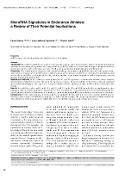MicroRNA signatures in endurance athletes: a review of their potential implications

Publication date
2024Published in
Rehabilitacja MedycznaVolume / Issue
28 (2)ISBN / ISSN
ISSN: 1427-9622ISBN / ISSN
eISSN: 1896-3250Metadata
Show full item recordCollections
This publication has a published version with DOI 10.5604/01.3001.0054.7756
Abstract
Introduction: MicroRNAs (miRNAs) are regulators of post-transcriptional gene expression that reflect individual biological adaptations to environmental exposures. Measuring circulating miRNAs offers a way to evaluate biological changes from behavioural interventions, such as exercise and sports, which relate to adaptation, muscle damage and inflammation. Objectives: This review aims to summarize the current knowledge about circulating miRNAs associated with sports, endurance exercise, training and the identification of cardiovascular, as well as myocyte disorders in humans. It is primarily focused on the role of miRNAs in endurance and aerobic training and their regulation in response to cardiac hypertrophy, myocyte damage, fibrosis and inflammation. Material and methods: In this review, the existing literature on miRNA expression is examined in various exercise contexts, identifying key miRNAs involved in the adaptive response to exercise. Research included in the review primarily employed quasi-experimental designs, focusing on pre-and post-exercise miRNA expression changes in elite athletes and healthy indi-viduals. Results: Key miRNAs, such as miR-1, miR-133, miR-21, miR-155, miR-206, miR-208 and miR-146, are highlighted for their significant roles in exercise adaptation. Two key future research directions are identified in the review: investigating the biological pathways linked to different exercise modalities and understanding miRNA expressions in various exercise contexts. Conclusions: Despite varied findings, the review allows to emphasize the need for future research to explore miRNA-gene interactions and the impact of different training types as well as durations, especially comparing athletes to healthy populations. This will help to better understand the relationship between miRNA expression and exercise performance.
Keywords
aerobic exercise, biomarkers, miRNA, movement intervention, sport
Permanent link
https://hdl.handle.net/20.500.14178/2839License
Full text of this result is licensed under: Creative Commons Uveďte původ-Zachovejte licenci 4.0 International



